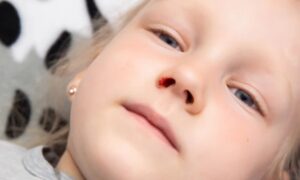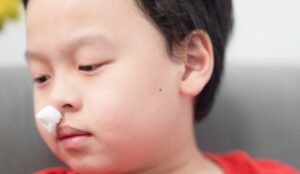When Do Children Start Showing Symptoms of Myopia?
Many parents are concerned about—when do children start showing symptoms of myopia? Nowadays, most children are exposed to various electronic devices from an early age, especially smartphones and tablets, which put a heavy burden on their eyes. Have you ever heard someone say, “My child seems to have blurry vision when looking at things far away. Could it be myopia?” This kind of question often makes parents anxious. Today, I'll help answer this, and explain when children are likely to start showing symptoms of myopia, how parents can observe these signs, and what actions they should take.
Symptoms of Myopia: Can You Spot Your Child's Eye Problems?
First, let's look at the common symptoms of myopia that children may experience. As parents, it’s important to notice these signs early so that effective prevention and treatment measures can be taken.
1. Blurry Vision for Distant Objects
This is one of the most common symptoms. Children may notice that distant objects appear blurry, especially when looking at the blackboard in class or watching something on a TV screen. If you notice your child squinting to see things clearly or often sitting very close to the TV, this could be a sign of vision problems.
2. Squinting or Tilting Their Head
If your child has a habit of squinting or tilting their head when looking at something, they may be unconsciously adjusting their viewing angle to see more clearly. If this happens frequently, it’s best to get their vision checked.
3. Headaches and Eye Fatigue
Some parents notice that their child frequently complains of headaches or eye discomfort, or that their eyes become red and swollen after reading or doing homework. This is often caused by eye strain from prolonged close-up activities. If your child says their eyes hurt or feel tired, this could be a signal that myopia is worsening.
4. Reading at a Close Distance
Have you noticed that your child holds books or devices like phones and tablets very close to their eyes? This happens because children with myopia instinctively bring objects closer to their eyes to see them more clearly. This is another common sign of myopia.
5. Avoiding Distance Activities
If you notice your child becoming less interested in activities that require good distance vision, such as playing basketball or soccer, and preferring to stay indoors or avoid outdoor play, this could be a sign of myopia. Myopic children may subconsciously avoid activities that require looking at things far away.
What Causes Myopia in Children?
Now that we know how to spot potential symptoms of myopia, let’s discuss the causes. The development of myopia is influenced by various factors, and here are the main ones:
1. Genetic Factors
Genetics play an important role in myopia. If both parents are myopic, the likelihood of their child developing myopia increases significantly. Studies show that if both parents are myopic, the child’s chance of developing myopia can be as high as 50%. However, even if the parents are myopic, the severity of the child's myopia may vary, and it largely depends on their postnatal eye habits.
2. Poor Eye Habits
Excessive use of electronic devices, prolonged close-up reading, and studying all add to the strain on the eyes. Especially in today’s digital age, many children are glued to their smartphones, tablets, or computers after school, often forgetting to rest their eyes. Overuse of the eyes is a major cause of myopia in children.
3. Lack of Outdoor Activities
Many parents may overlook one important factor: outdoor activities. Studies show that children who spend at least two hours a day outdoors have a significantly lower risk of developing myopia. This is because exposure to outdoor light, especially sunlight, helps stimulate the proper development of the eyes. Unfortunately, many children nowadays spend most of their time indoors, which results in increasing vision problems.
4. Poor Nutrition
The health of the eyes is closely tied to overall health, and poor nutrition can contribute to myopia. If a child’s diet lacks certain key nutrients, such as vitamins A, C, and E, it can negatively affect eye development and increase the risk of myopia.
When Should You Take Your Child to See an Eye Doctor?
Parents should keep a close watch on any changes in their child's vision. If you notice symptoms like blurry vision, squinting, frequent headaches, or eye discomfort, it’s a good idea to take your child to a professional eye doctor for a check-up. An eye exam can confirm whether the child has myopia and determine the appropriate treatment plan based on the results.
How Can You Prevent Myopia in Children?
Now that we know the symptoms and causes of myopia, what can parents do to help prevent it? Here are some practical tips:
1. Increase Outdoor Activity Time
Encourage your child to spend at least two hours outdoors every day. Activities like running, playing soccer, or cycling are great. Exposure to sunlight helps stimulate eye development and reduces the risk of myopia.
2. Control Screen Time
Too much screen time on devices like smartphones, tablets, and TVs can significantly impact a child’s eyesight. Limit screen time to no more than one hour per day, especially for children under the age of three.
3. Encourage Regular Eye Breaks
When your child is reading or doing homework, remind them to take a break every 30 minutes and look at something far away to rest their eyes. This will help prevent eye fatigue and strain.
4. Maintain Good Posture
Teach your child to maintain proper sitting posture and keep a safe distance when reading or using electronic devices. The distance between the book and the eyes should be about 30-40 centimeters (12-16 inches).
5. Regular Eye Check-ups
Even if there are no obvious symptoms, it's important to get your child’s vision checked regularly. Especially after the age of six, when their eyes are still developing, early detection of myopia and prompt intervention can help slow its progression.
Conclusion
In summary, myopia symptoms can often be detected through simple signs, and as parents, we need to keep a close eye on any changes in our child's vision. Early detection and intervention can make a big difference in managing myopia. By encouraging outdoor activities, controlling screen time, maintaining good eye habits, and scheduling regular check-ups, we can significantly reduce the risk of myopia. I hope today's discussion helps you pay more attention to your child's eye health and prevent myopia from affecting their growth and learning.
References:
- Zhang, H. et al. (2020). Genetic Factors and Childhood Myopia: A Study on Twin and Family Pedigree Data. Journal of Pediatric Ophthalmology and Strabismus.
- Lanca, C. et al. (2020). Outdoor Activity and Myopia: A Meta-Analysis of Risk Factors and Prevention Measures. Ophthalmology Journal.
- Smith, R. (2019). Nutrition and Eye Health: Effects of Vitamin Deficiency on Vision. Journal of Eye Health.
- Williams, P. et al. (2021). Effects of Outdoor Play on Childhood Myopia Development. International Journal of Pediatrics.








